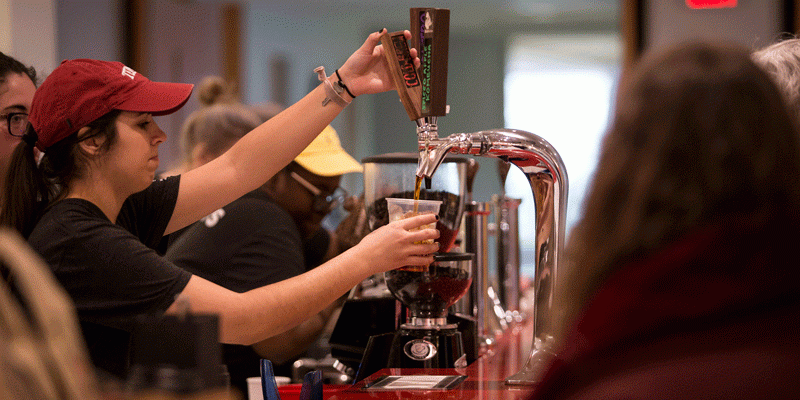Posted March 6, 2018
Ambler students showcase the Schuylkill at Flower Show
This year’s Temple exhibit, “Within Reach: Unlocking the Legacy of Our Hidden River,” simulates a canal, coal mine and a freshwater tidal marsh, and contains more than 50 species of plants indigenous to Pennsylvania.
Video Production:
Gina Benigno and Louis Peluyera
For inspiration to construct their exhibit for this year’s Philadelphia Flower Show, Temple’s team of students and faculty didn’t have to search far: They found it in their own backyard in Pennsylvania.
The Flower Show theme this year, “Wonders of Water,” inspired Associate Professor Rob Kuper and adjunct Assistant Professor Michael LoFurno, who teach the Tyler School of Art's junior landscape architecture design-build studio class that designs and constructs each year’s exhibit, to showcase the plants and topography of Pennsylvania’s coal region and the Schuylkill River.
“We’re drawing upon the idea of a coal mine, particularly in the Piedmont region of Pennsylvania, which once served as the origin of the Schuylkill navigation system, so we’ve recreated the idea of leaving a coal mine,” Kuper said. “People move up the ramp and into a different region, where there are plants overhanging the pathway ... then they emerge into a more open environment where we have water moving through a sluice gate and into canals and different elevations. They’ll exit the exhibit going down a ramp and through a depiction of a tidal freshwater marsh.”
The exhibit, “Within Reach: Unlocking the Legacy of Our Hidden River,” features numerous materials, including crushed asphalt, scorched cedar planks meant to simulate the look of an underground coal seam, steel, rusted corrugated sheet metal, and PVC pipes used to construct a tidal marker that represents the hourly change in the Schuylkill’s water levels in a 24-hour period. More than 50 species of plants indigenous to Pennsylvania and grown at Temple Ambler, including allspice; maple and pine trees; witch hazel; and the rarely cultivated aralia spinosa, or “devil’s walkingstick,” are being used in the intricate exhibit.
Kuper and Benjamin Snyder, TYL ’16, a horticultural technician at Temple Ambler, said Temple’s exhibit is likely the only one at the Flower Show to feature devil’s walkingstick.
“It’s a native thicket-forming plant to this region found along roadsides and other wastelands,” Snyder said. “It has a really cool structural habit, very thorny, even in the winter, and has a cool presence in the landscape.”
Kuper and LoFurno gave students in this semester’s class their schematic plan in the fall, and when students started class in January, they broke into groups and developed plans to build the exhibit. Last week, they moved their plants and materials to the Pennsylvania Convention Center, where they spent several days setting up and perfecting their display. Flower Show guests will enter the exhibit through a tunnel-like structure, then emerge amid a thick of lush greenery and continue through to the simulated tidal freshwater basin.
Every turn that we expect a visitor to make, we hope to have something there for them to view, so that every time they reorient themselves, they’re looking at something different, a new focal point, a new experience, a new activity of some sort or a new element."
-- Rob Kuper, associate professor
“Every turn that we expect a visitor to make, we hope to have something there for them to view, so that every time they reorient themselves, they’re looking at something different, a new focal point, a new experience, a new activity of some sort or a new element,” Kuper said.
The design-build studio class that each year allows students to plan, design and build an exhibit for the Flower Show is rare not only in the region, but in the country, Kuper said. Not many courses offer students the same level of hands-on experience on a real project. Temple’s exhibits regularly win honors at the Flower Show, including a Pennsylvania Horticultural Society Gold Medal award, among others, last year, and a National Park Service Director’s Award in 2016. This year’s exhibit was no exception, winning a Pennsylvania Horticultural Society Silver Medal, the Chicago Horticultural Society Flower Show Medal and a Special Achievement Award of the Garden Club Federation of Pennsylvania.
“I don’t know of any other landscape architecture program that has this kind of experience where you actually get to design and build something, which you’re going to be doing in your career, then seeing it through and seeing how people enjoy it when you’re there staffing the exhibit,” said Alex Booth, a junior landscape architecture major in the class. “It’s been interesting, for sure. It’s been a lot of problem-solving.”
The Landscape Architecture and Horticulture program is housed in Temple's Tyler School of Art and based on the Ambler Campus.


